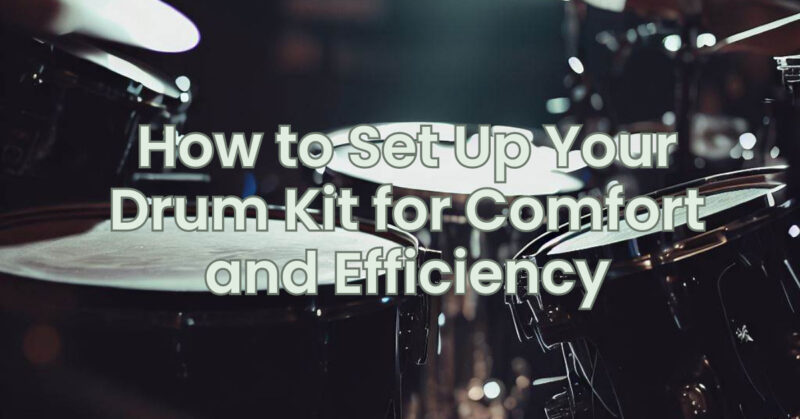Setting up your drum kit correctly is essential for achieving comfort, ease of playing, and efficient movement around the drums. A well-organized drum kit setup allows you to play with better technique, reduces the risk of strain or injury, and enhances your overall performance. In this step-by-step guide, we’ll walk you through the process of setting up your drum kit for optimal comfort and efficiency.
- Determine Your Ideal Drum Kit Configuration: Consider the musical style you play and your personal preferences when deciding on the drum kit configuration. Determine the number of drums, cymbals, and other accessories you want to include in your setup. This will help you plan the placement and arrangement of the components.
- Position the Bass Drum: Start by placing the bass drum in front of you. Position it at a comfortable height and angle. The drumhead should be easily reachable by your foot, allowing for effortless pedal control. Ensure that the bass drum pedal is properly attached and aligned with the center of the drumhead.
- Set Up the Snare Drum: Place the snare drum between your legs, slightly tilted towards you. Adjust the snare drum stand height so that the drumhead is at a comfortable playing height. The snare drum should be positioned within easy reach of your hands, allowing for fluid movement and precise stick control.
- Arrange the Toms: Position the tom drums to your right and/or left, depending on your preference. The rack tom(s) should be placed at a height and angle that allows for comfortable and ergonomic reach. The floor tom(s) can be positioned slightly lower and angled towards you. Experiment with different heights and angles to find the most comfortable and efficient positioning.
- Place the Hi-Hat Cymbal: Position the hi-hat stand to your left, within easy reach of your left foot and left hand. Adjust the height and angle of the hi-hat cymbals so that they are at a comfortable playing position. Ensure that the distance between the hi-hat cymbals allows for smooth foot control and precise stick work.
- Arrange the Ride and Crash Cymbals: Place the ride cymbal to your right, typically above the floor tom. Adjust the height and angle of the ride cymbal to your preference, ensuring that it is easily reachable without straining your posture or movement. Position the crash cymbal(s) within easy reach, considering the musical style and your playing technique.
- Organize Additional Percussion and Accessories: If you use additional percussion instruments, such as cowbells, tambourines, or electronic pads, position them within reach and in a logical and ergonomic order. Consider the frequency of use and prioritize the placement accordingly. Also, ensure that drumstick holders, tablet holders, or any other accessories are positioned conveniently for easy access.
- Adjust Throne Height and Drum Stool Position: Set the height of your drum throne or drum stool so that your thighs are parallel to the ground when seated. This allows for proper leg and foot positioning and reduces strain on your back and legs. Adjust the drum stool position to find a comfortable distance from the drums and cymbals.
- Fine-Tune and Test: Once you’ve set up your drum kit, sit behind it and take some time to play and evaluate the setup. Pay attention to your comfort, reach, and ease of movement. Make any necessary adjustments to height, angles, or distances to achieve optimal comfort and efficiency. Experiment with different setups and test them in different playing scenarios to find the configuration that works best for you.
- Maintain and Refine: Regularly check and adjust your drum kit setup as needed. Over time, your playing style, technique, or musical preferences may change, requiring adjustments to optimize comfort and efficiency. Continuously refine your setup to accommodate these changes and ensure a comfortable and enjoyable drumming experience.
Remember, everyone’s preferences and body types are unique, so feel free to experiment and make adjustments to your drum kit setup based on your specific needs. A well-organized and ergonomically designed drum kit will not only enhance your playing experience but also contribute to improved technique, reduced strain, and increased efficiency in your drumming.


